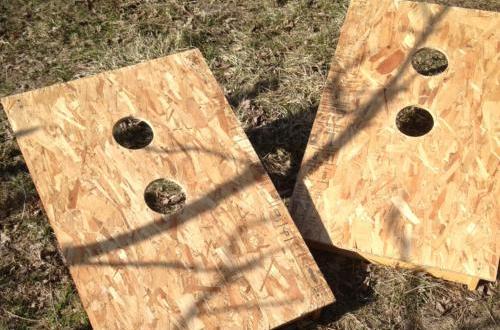The game
I first played "cornhole" in Ithaca, NY. A simple backyard game with two teams, tossing beanbags towards a target board. Points are scored for bags resting on the inclined target as well as those bags passing through a hole. When we moved into a new house in Saint Paul, I found that a previous tenant had left a set of boards and bags behind. Cool! But why not liven up the game a bit with some interactivity?
The electronics
I had seen the heartbeat straightjacket tutorial on SparkFun and I knew I wanted to work with electroluminescent wire. It's a flexible, glowing wire that is often used in wearable electronics.  I liked how the light was uniform along the length, in contrast to most LED strips. The particle boards got a heavy-duty sanding followed by a couple coats of fresh paint. And I have no idea why the boards have two holes instead of just one, but, hey, let's just roll with it, no?
I liked how the light was uniform along the length, in contrast to most LED strips. The particle boards got a heavy-duty sanding followed by a couple coats of fresh paint. And I have no idea why the boards have two holes instead of just one, but, hey, let's just roll with it, no?
Then, I figured I needed at least two kinds of sensing elements: one to detect when a bag hit the board, and another to see if a bag passed through the hole. I used these piezo sensors to detect the board "knocks," and these other piezo sensors to be struck by the bags as they dropped through the holes. Then we need a specialized power source for the EL wire, since it runs on high frequency AC; luckily, SparkFun (or any EL vendor) has what we need. I needed some semiconductor components to switch the lights on and off; you could buy an off-the-shelf solution, but I decided to build my own. I also had to make a trip to the hardware store for boxes to hold the components and PVC plumbing fittings to make "chutes" for the holes.
Parts list
- 8x TRIACs
- 8x Opto-isolators
- EL wire: I used "high bright standard" with Aqua, Yellow, Lime Green, and Red. Just over forty feet is enough to go around the edge of both boards.
- Arduino
- Plenty of batteries for power and a way to hold them (don't forget rechargeables are only 1.2V)
EL Cornhole
I battled through a few bugs in the setup... the most frustrating was some strange interference between the high frequency AC driver of the EL wire and the chute piezo sensors. When the current-carrying wires got too close to the piezo signal wires, the analog signal read by the Arduino got extremely noisy. I finally got some decent results. The main issue is the intensity of the lit EL wires. I knew they would not be as bright as LEDs, but I wanted the uniform glow from the wire rather than discrete bright LEDs. Unfortuntely, it has to be nearly dark outside to observe the full effect, at which point it becomes somewhat difficult to play the game. Ideally, one would play this at night, near a firepit or with some decent torches or other ambient light. The video below shows the game in-action.